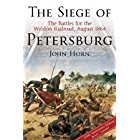On Wednesday, March 3, 2021, at 6 p.m., I'll be talking in person to the Kankakee Valley Civil War Round Table in the Bradley Public Library in Bradley, Illinois. The subject will be my most recent book, The Petersburg Regiment in the Civil War: A History of the 12th Virginia Infantry from John Brown's Hanging to Appomattox, 1859-1865 (SavasBeatie, 2019), which won the 2019 Army Historical Foundation Distinguished Writing Award for Unit History.
The talk will focus on the Petersburg Regiment's distinguished writers--its soldiers. The book draws on the writings of more than 30 of the soldiers. My presentation cannot cover them all within the allotted time. Therefore I will focus on the most prolific or vivid. By company, they are (italics designate soldiers who joined the regiment more than once, and bold designates members of the color guard):
Cameron, William Evelyn: enl. 6/4/61 Petersburg pvt. Co. A, b. 1842, r. Missouri; elected 2 lt. Co. D 6/14/61; not reelected 5/1/62. Com. lst. lt. 5/18/62, appointed regimental adjutant; WIA 8/30/62 severe; capt. 11/2/63; Appomattox.
Capt. William Evelyn Cameron
Courtesy of Virginia Historical Society
Bird, Henry Van Leuvenigh: enl. 4/19/61 Petersburg pvt. Co. C; b. 1843, store clerk, r. Petersburg, clerk; WIA 7/1/62; POW 10/27/64. Nicknamed “Birdie.”'
Pvt. Henry Van Leuvenigh "Birdie" Bird
Courtesy of Virginia Historical Society
Bernard, George Smith: enl. 4/19/61 Petersburg pvt. Co. E, b. 1837 Culpeper Cty., r. Petersburg, lawyer; med. dis. 10/30 61. Enl. 2/22/62 Hicksford sgt. 2nd Co. I; WIA & POW 9/14/62 right leg severe; trans. Co. E, voluntarily reduced to pvt.; WIA 2/6/65; furloughed 3/20/65.
3rd Sgt. George S. Bernard, wounded, beside 1st Lt. Joseph Richard Manson (holding flag) at Crampton's Gap, September 14, 1862
From Bernard, ed., War Talks of Confederate Veterans
Todd, Westwood A.: enl. 9/13/61 Norfolk pvt. Co. A, b. 1831, lawyer, r. Norfolk; trans. Co. E 4/2/62; WIA 8/30/62 hand; became brigade assistant ordnance officer, then ordnance officer; POW 4/6/65.
Map by Hampton Newsome
Whitehorne, James Edward: enl. 6/6/61 Hicksford cpl. Co. F, b. 1840, r. Greensville Cty.; 1 sgt. 8/20/61; WIA 7/2/63 shell, both legs; WIA 7/30/64 leg, slightly; Appomattox.
1st Sgt. James Edward "Eddie" Whitehorne
Courtesy of Fletcher L. Elmore, Louisville, Kentucky
Phillips, James Eldred: enl. 4/19/61 Richmond pvt. Co. G, master tinner, r. Richmond; cpl. 9/1/61; sgt. 5/1/62; POW 9/14/62; 2 lt. 3/9/63; 1 lt. 11/20/63; Appomattox.
1st Lt. James Eldred Phillips
Courtesy of Virginia Historical Society
Whitlock, Philip: enl. 4/19/61 Richmond pvt. Co. G, b. 1836 Poland, clerk, r. Richmond; detailed 9/23/62 Quartermaster Dept.
Pvt. Philip Whitlock (in kepi upper right) opposite John Wilkes Booth (in kepi upper left) at John Brown's hanging
Sale, John Francis: enl. 5/17/61 Norfolk pvt. Co. H, b. 1842, contractor, r. Norfolk; cpl. 5/1/62; sgt. 6/1/62; WIA 7/1/62; 1 sgt. 12/1/62; 2 lt. 11/22/64; MWIA 2/6/65, deceased 2/12/65.
Map by Hampton Newsome
Manson, Joseph Richard: enl. 2/22/62 Hicksford 1 lt. 2nd Co. I, b. 1831 Brunswick Cty., planter, commission merchant, r. Brunswick Cty., married; POW 9/14/62; capt. 7/64; Appomattox.
1st Lt. Joseph Richard Manson late in the war
Courtesy of Richard Cheatham, Richmond, Virginia




































